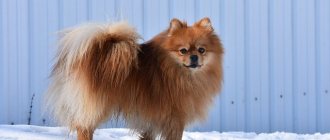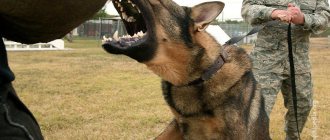Cheerful, friendly, flexible, obedient - this is how you can characterize a Toy Terrier dog.
This miniature dog gets along well with both children and other pets.
But, despite his good nature, this little ball of fur has a brave character and is quite capable of standing up for himself.
And yet, we should not forget that, like all small breeds, toy terriers have rather fragile health, requiring special attention and careful treatment.
What health problems this breed has and why they appear, you will find out in this article.
Is the breed susceptible to diseases?
Toy terriers are considered to be quite strong dogs that rarely get sick. But this does not mean that you should not pay attention to your pet’s health. After all, illnesses can turn a cheerful dog into a lethargic and exhausted one in just a couple of days. And some of them are capable of killing a baby in just a few hours .
There are a huge number of diseases to which toy terriers are susceptible. At the same time, they are conventionally divided into several categories depending on which organ or system they affect.
The main diseases of toy terriers:
- diseases of the musculoskeletal system;
- eye diseases;
- dental problems;
- neuralgia;
- allergy;
- gastrointestinal diseases;
- skin diseases;
- other diseases (viral, infectious diseases, helminthic infestations, presence of parasites, etc.).
Expert opinion
Tolkachev Andrey Mikhailovich
veterinarian
Only a professional veterinarian can provide qualified assistance to a dog. Only he can correctly diagnose and determine the causes of certain symptoms. If your dog’s abnormalities are mild and short-lived, this is not dangerous. But if the symptoms do not stop within 24 hours, then it’s time to go to the clinic. And one more thing - never neglect vaccination and preventive examinations of the animal.
Life expectancy of toy terriers
With a height of 30 centimeters, Russian toys weigh no more than 3 kilograms. Oddly enough, given their size, terriers live longer than many large breed dogs.
For example, the average life expectancy of Great Danes is 8 years, and that of Airedale Terriers is about 14 years. And most toy terriers are over the 15-year mark.
Mortality of small terriers at an earlier age is usually associated with the inexperience of the owners or their irresponsibility.
With proper feeding, care, and proper physical activity, the number of years a toy terrier can live can reach two dozen.
This is partly due to the ability of terriers to quickly recover from illness. However, this does not mean that you do not need to support your dog’s immunity.
This is interesting! The absolute long-living champion among Russian terriers is a baby who has lived for 30 years.
It is worth mentioning separately the variety of terriers belonging to the “mini” class. They are smaller in size (usually their weight does not exceed 2 kg). Their frail build makes them more susceptible to injury and other health problems.
As a rule, small sizes are the result of either genetic abnormalities or congenital diseases.
Dwarf toy terriers live an order of magnitude shorter - about 5 years. Therefore, when buying, you should carefully choose a puppy.
A healthy baby is well-fed, active and shows interest in the world around him.
Main symptoms of ailments
Sound the alarm immediately when your pet shows any of these symptoms:
- lethargy and depression;
- unnatural color of stool (black, white, greenish);
- bloody urine;
- body temperature above 39 degrees;
- the animal's refusal to eat;
- pale or reddish skin tone;
- discharge from the eyes and ears;
- dull fur;
- convulsions;
- lameness;
- sensitivity to light;
- clouding of the cornea of the eye.
Reviews
Katya, Samara: “We adopted a short-haired Toy as a puppy from a nursery a year ago. Nice baby. Eats well, playful, affectionate. We have never regretted it yet. The whole family loves him."
Natalya, Minsk: “They gave me a toy for my birthday. I was even confused when I saw the puppy. I can now say that it was the best surprise of my life. Cool, handsome toy terrier boy.”
Victor. Kaluga: “My mother also has a black and white one. She dotes on him. Sometimes it seems that the dog is more valuable to her than everyone else. He carries his terrier with him everywhere. And if he leaves, then he will call 10 times a day and ask about the dog.”
Problems with the gastrointestinal tract
The most common manifestation of gastrointestinal diseases in toy terriers is:
- vomit. Causes: foreign body entering the esophagus, viral diseases, poisoning, heat stroke, helminths. Preliminary treatment: keep the dog on a starvation diet for 24 hours, give it no-shpa (this will reduce the spasm). It is also recommended to give the dog “Smecta” to remove toxins from the body and “Cerucal” to calm the gag reflex;
- diarrhea _ Causes: unsuitable food, liver disease, poor diet, poisoning, reaction to a vaccine. Help: keep the dog on a starvation diet for a while, while giving water and activated charcoal. After the diarrhea stops, give your pet yogurt or bio-kefir;
- Diarrhea with blood most often occurs when a foreign body enters the intestines, tumor processes in the intestines, parvovirus enteritis, poisoning, hemorrhoids and anal fissures. Regardless of the cause, treatment is carried out only in a veterinary clinic;
- constipation _ The reasons are the predominance of meat products in the diet, insufficient drinking, lack of fibrous foods in the diet (vegetables, fruits), and overeating. Treatment: give the dog a weak decoction of buckthorn or an infusion of pumpkin seeds (1 teaspoon per ½ cup of boiling water). You should also exclude fatty meats, flour products, dry food and bones from your diet.
The basics of proper feeding
Despite their tiny size, toy terriers are carnivores and therefore require constant protein food. The daily menu of representatives of this breed must include meat. It is worth noting that pork and lamb are strictly contraindicated for them. The diet of terriers should also contain fermented milk products, cereals and boiled eggs. It would be a good idea to enrich your pet’s menu with boiled vegetables once a day. In turn, it is recommended to protect the dog from sweet and flour products, as well as legumes and spicy foods.
Feeding your toy terrier should be on a schedule. Up to 4 months, the daily diet of puppies should be divided into 5 parts. From one year old, the pet should receive food 3 times a day. With age, the dog itself will begin to dose its daily menu.
Skin diseases
The most common problems in Toy Terriers are dandruff and hair loss (baldness).
Baldness
If a dog is going bald, this is a sign of the following diseases and disorders in the body:
- eczema;
- age-related changes;
- metabolic disease;
- improper diet of the dog;
- furunculosis (inflammation of the salt gland of the hair follicle).
Symptoms include symmetrical or focal hair loss in different parts of the body.
Treatment for baldness is prescribed depending on the causes that caused it. To restore hair, the doctor prescribes Trilostane and Metaonine.
Dandruff
The most common causes of dandruff in Toy Terriers:
- too dry air;
- poor nutrition;
- the presence of parasites (fleas, lice, ticks, worms);
- incorrectly selected hygiene products.
Treatment - treat the dog with antiparasitic agents and give deworming medication, and also select grooming products that do not cause dandruff. The products must be suitable for the pet. In addition, humidify the air in the room and comb out the scales with a special brush.
Musculoskeletal system
Very active dogs. They love to jump. This could end in trauma for them. Dislocations and fractures are possible.
In this case, an operation will be required, as a result of which a pin is inserted into the broken limb.
There are also genetic diseases of the musculoskeletal system. For example, Legge-Calvé-Perthes disease or aseptic necrosis of the femoral head.
Signs of this disease can appear in a one-year-old dog, although the disease itself begins to develop in six months.
The main symptom of medial patellar luxation is the dog limping and walking on bent legs.
It is important to treat your pet on time
. After all, if you ignore the problem, limb atrophy may occur.
Eye diseases
If your Toy Terrier’s eyes are watery or purulent, then know that this phenomenon may have several reasons:
- conjunctivitis . It is characterized by inflammation of the mucous membrane of the eye, redness of the whites, and sensitivity to light. If the cause is viruses, then drops containing an antibiotic are prescribed. If there is an allergy, then the dog should be given antihistamine drops, tablets, non-steroidal ointments;
- obstruction of the lacrimal canals . Causes: congenital anomalies, cysts or neoplasms, infections, injuries. Treatment - antibiotics, anti-inflammatory drugs and drops, as well as surgery;
- Chlamydia and mycoplasmosis can also cause purulent discharge from the eyes Treatment - eye ointments with tetracycline and erythromycin, fluoroquinolones and aminoglycosides;
- eyelid tumors (benign or malignant). Any tumor irritates the conjunctiva of the eye and puts pressure on the lacrimal canal, which leads to excessive flow of tears and the formation of pus. Treatment is surgery.
Stages of development
Puppies are born toothless, and the first teeth begin to appear only after a month. The jaw and teeth do not grow at the same rate, so you may feel like there is too much space between them. This will be corrected when they are replaced by permanent ones. The animal either swallows or loses its milk teeth.
The last thing to fall out is the fangs. They have a pointed shape and are fragile. With normal development in decorative dogs, the shift should end by the seventh month; in large breeds this happens somewhat faster.
Causes and treatment of allergies
The most common causes of allergies in toy terriers:
- unsuitable food products;
- allergies to medications;
- reaction to insect bites;
- infections;
- reaction to the fur of other animals;
- allergies to household chemicals and care products.
Treatment methods:
- change in diet;
- introduction of homeopathic remedies;
- protecting your pet from allergy sources;
- antihistamines. The dosage should only be determined by a veterinarian in accordance with the weight of the animal;
- use of steroid ointments;
- antibiotics (if the cause is infection);
- Radiation therapy helps with severe forms of allergies.
Raising a pet
The Toy Terrier is much easier to train than representatives of many other breeds. This is a very smart dog that can easily learn any commands. When raising a pet, it is important that he understands and fulfills the owner’s requirements from the first time. It is recommended to practice commands on the street and at home so that the dog follows them regardless of its environment.
Toy terriers very quickly understand where their toilet is, what things cannot be chewed, and from whose hands they can eat. The main thing is to set the limits of what is permitted to your pet in a timely manner and clearly explain them to him.
Smell from the mouth
If your pet has bad breath, this is a reason to contact your veterinarian immediately. After all, a bad smell is a sign of illness.
If the dog does not have any diseases, then the cause of the smell is tartar or lack of care for the pet’s mouth.
What do we have to do:
- diversify your diet. Your pet's menu must include apples, carrots, and soft vein bones;
- To make it easier to remove plaque, give your pet tomato juice. At each feeding, add 1-2 tablespoons of tomato juice to your food and after 2 weeks you can easily remove plaque;
- take care of your pet's mouth. This includes regular teeth cleaning and tartar removal.
Video
If you haven't taken care of your little pet and he has problems with his ears, they need to be cleaned of pus. This can be done either independently or by contacting a specialist. In this video you will learn how to carry out this procedure yourself.
They entered a person's life. These tiny creatures cannot leave others indifferent. Weightlessness, a pretty face with smart eyes, and a lively character make the life of dog owners positive and filled with pleasant worries.
However, babies are susceptible to diseases
and in order to make your pet’s life carefree, you need to know about the main problem areas of toy terriers
. Also about diseases that lie in wait for dogs, their main symptoms, treatment methods. Following the vaccination schedule will avoid many problems associated with the health of toy terriers.
The length of its life depends on how carefully the owners take care of the pet. In order for the care to be correct, you need to know the problem areas of the dog.
. There are many of them, these tiny creatures are susceptible to a number of diseases that require immediate treatment.
- Teeth.
When a puppy is six months old, his milk teeth begin to fall out, and the growth of his molars immediately begins. The problem is the formation of “double teeth” - the milk teeth have not yet fallen out, the molars have already grown. In this case, you need to contact a veterinarian so that he can professionally perform the operation of removing baby teeth. At the same time, it will remove the stone that forms on the teeth of children. - Bones.
The size and weight of the dog are small. Her bones are fragile and she is susceptible to various types of fractures, especially her kneecap. Therefore, it is necessary to be careful about contact with other dogs. Do not allow your friend to jump from a height of more than half a meter or perform other dangerous actions. The Toy Terrier sometimes cannot balance its strength and tries to do things beyond its control or measure its strength with large dogs. - The influence of cold.
Rather, the cold will not become a problem if the owners do not take their pet out for a walk during the cold season for no reason without appropriate protection.
Important!
A blanket for a toy terrier is an integral part of life and a guarantee of health. Fortunately, there is now a wide choice of clothing for animals.
Dental care
The fact that the Toy Terrier is a small breed dog does not mean that it has fewer teeth than others. There are as many of them as other breeds. The toy has 20 teeth on the upper jaw and 22 on the lower jaw. An adult healthy dog has 42 teeth.
Between 4 and 6 months after birth, the puppy's baby teeth change. The root of the baby tooth dissolves and the crown becomes loose. By the age of 8 months, the process of changing teeth is completely completed.
Between the ages of 1 and 2 years, your dog may experience loose molars that may fall out.
Causes of loss of molars:
- hardened plaque, which over time destroys the chewing organ;
- advanced gingivitis is a disease that causes inflammation of the gums, leading to loose teeth and tooth loss;
- periodontitis is an inflammation of the gums, accompanied by bleeding, pus and pain.
Dental treatment plan for a toy terrier in a clinic:
- Carrying out diagnostics and taking tests;
- Cleaning teeth, removing tartar, removing decayed and broken teeth;
- Prescription of anti-inflammatory, antiseptic and enzyme drugs to eliminate inflammatory processes;
- If there is no improvement, then antibiotics are prescribed.
Teeth cleaning:
- buy cotton swabs or a children's toothbrush, as well as toothpaste for dogs and a hook for removing tartar;
- If possible, position the dog so that it is comfortable for both you and her. Some people advise placing the baby on your lap;
- walk over your pet's teeth with a cotton swab or toothbrush with toothpaste, moving from the gums to the edge of the tooth. Pay special attention to the painters (far teeth);
- now, if there is plaque, carefully remove it with a hook or an orange stick. If the plaque has already become hard, you will have to visit a veterinarian.
NOTE!
When brushing your teeth, your goal is not to scare your pet. Accustom him to the procedure gradually, talk to him, encourage him.
How to toilet train
Teaching a puppy to be clean is a priority for its owners. It is best to toilet train your pet before the age of two months. A special cage with a tray is well suited for this. Puppies often relieve themselves in the same place where they sleep. After a few days, the tray will be saturated with the smell, and it can be removed from under the cage. Subsequently, the puppy will need to be regularly placed on it so that it understands where to relieve itself in the future.
The Toy Terrier, whose care and maintenance does not require special skills, is rightfully considered one of the cleanest and smartest dogs.
There is an opinion that representatives of this breed do not need to be walked outside, as they can relieve themselves in a litter box, like cats. In the case when there is severe frost or windy rainy weather outside, this option is the most acceptable. However, nature always takes its toll, and if you confine your pet within four walls, whining and barking will not take long to occur.
Caring for a toy terrier involves regular walks in the fresh air. A dog can stay outside for a long time if the weather permits it. Upon returning home, you should wash your paws and be sure to wipe them dry.
The appearance of seizures
Causes of seizures in a toy terrier:
- epilepsy . It can be inherited or caused by head trauma, complications from infection, tumors, etc.;
- diabetes mellitus and complications after it. Typically, convulsions in this case appear due to an acute lack of glucose;
- poisoning (severe intoxication of the body). As a rule, this happens when a dog is poisoned by poisons such as arsenic, rat poison, insect repellent, etc.;
- infectious diseases . Their causes are viruses, bacteria, fungi. Very often, convulsions occur after a tick bite. In this case, an increase in temperature, discharge from the nose and eyes, and intestinal disorders are often observed;
- inflammatory processes of internal organs . The most common cause is an infection in the dog’s body, which causes a variety of diseases (meningitis, hepatitis, nephritis, etc.). Cramps are just symptoms;
- heart diseases . In addition to seizures, heart disease in Toys is accompanied by shortness of breath, cough, and bluish skin;
- oncological formations in the brain . With this disease, the pet may have severe convulsions, unsteady gait, weight loss, and inappropriate behavior.
First aid for seizures:
- transfer the animal to a flat surface and make sure that it does not injure itself or choke on saliva;
- turn off the radio and TV, loud sounds can aggravate the dog’s condition;
- drop a drop of Valocordin on your pet’s tongue - this will help him come to his senses quickly;
- Injections of magnesium sulfate can help your pet, but this should only be done with the permission of a veterinarian;
- if the dog has come to its senses, you should not feed it immediately, it is better to give the pet some boiled water at room temperature;
- Diazepam and Phenobarbital are often prescribed for seizures in toy terriers. But they can only be given after consultation with a veterinarian.
IMPORTANT!
After the seizures have stopped, take your pet to the vet immediately!
Causes and treatment of cough
There are several associated symptoms to look out for if your dog is coughing:
- discharge from the nose and eyes, inflammation of the mucous membranes;
- weight loss;
- apathy;
- increased breathing rate;
- uneven breathing;
- increased body temperature;
- enlarged lymph nodes.
Schemes and methods of treating cough depend on the causes that caused it.
Causes and treatment of cough:
- dry cough occurs with viral and infectious diseases. In this case, the dog is prescribed antiviral drugs or antibiotics, as well as expectorants;
- If the dog is coughing due to a foreign object getting into the throat, carefully examine the mouth and try to remove it. If the cough does not go away, contact your veterinarian;
- if the cause of the cough is an allergy, then the pet should be treated only after the allergen has been definitively identified. Treatment - antihistamines, special diet and isolation from the irritant;
- helminthic infestation can cause tracheobronchitis in a dog and, as a result, a suffocating cough. This disease should be treated only with antiparasitic drugs;
- A lung tumor almost always causes a cough in a Toy Terrier. Bronchodilators, steroids and bronchodilators will help alleviate the condition. If the tumor can be removed, the pet will be able to completely get rid of the cough.
Also read about what to do if your toy terrier is wheezing and choking.
How to choose a toy terrier
The first step when buying a puppy is to ask the breeder to show him his mother. It would be useful to see the baby’s father, but most often the males are with other owners. When examining the mother, it is important to pay attention to whether she is a calm and balanced dog with a traditional anatomical build. If she begins to tremble, be afraid or show excessive aggression, then this indicates instability of her mental state, which can be transmitted at the genetic level.
It is also worth paying attention to the behavior of the puppy itself. The Toy Terrier breed is distinguished by its activity and playfulness. As for external signs, the puppy should have shiny fur without visible bald patches. It is worth noting that a young toy terrier has several areas where skin can be visible, for example at the temples and in the chest area. It is important to keep your dog's ears and eyes clean. Any discharge in these areas indicates that the puppy is sick. The nose should be moist and slightly shiny.
When choosing a pet, it is recommended to pay attention to its teeth. A toy terrier should have one even if he is only about a month old. It is important that the canines are not moved forward or backward. By 1.5 months of age, the puppy should have 12 primary incisors.
When purchasing a toy terrier, you should also find out its pedigree, which is recorded in a special passport of its parents. After the first vaccinations, the puppy receives its own document certifying its basic veterinary indicators. Many diseases are widespread in small dogs, which can subsequently be transmitted to other animals and owners. Therefore, when choosing a pet, it is so important to note the vaccinations given to it, and then its pedigree.











